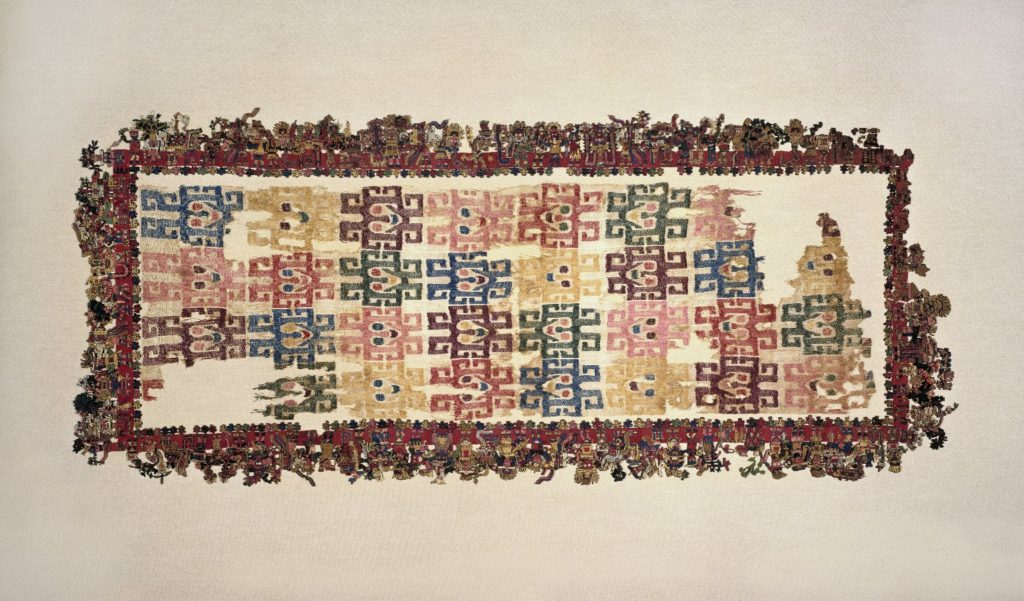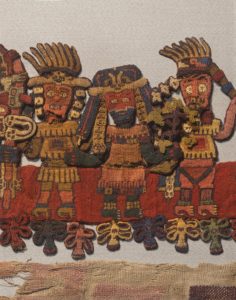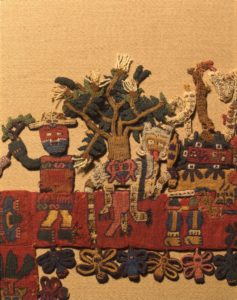
Mantle (“The Paracas Textile”), Nazca, 100-300 C.E. Cotton, camelid fiber, textile: 58 1/4 x 24 1/2 in. (148 x 62.2 cm). Brooklyn Museum, John Thomas Underwood Memorial Fund, 38.121 (Photo: Brooklyn Museum)
Can a cloak tell a story?
Yes, and this one tells a story unlike any other. This is an Andean mantle, or cloak, made of cotton and camelid fibers. It was found in Paracas, Peru, for which it was named “The Paracas Textile.” This name often confuses it with other textiles made by the Paracas culture, which show similar styles and techniques. Yet the Paracas artifacts date to nearly 2,500 years old – and this cloak is only about 2,000 years old.
That’s because it wasn’t made by the Paracas. The cloak you see here was made by the Nazca (also spelled Nasca), who were the Paracas’s neighbors. They lived before the Inca and Aztecs, in the river valleys of the Rio Grande de Nazca and the Ica Valley. Ruled by local chiefs, the Nazca created many types of crafts and technologies, including the famous pyramid mounds and Nazca lines that dot the landscape today. Their religion was based on agriculture and fertility, with powerful nature gods and the tradition of carrying “trophy heads.”
This textile tells their story. Likely woven by a team of women using a backstrap loom, it might have even been worn by a woman during ceremonies! Measuring two feet by five feet, the cloak depicts Nazca religion in a way never seen before. Many of the images focus on agriculture, with native plants and animals as well as cultivated plants.

Close-up #2 of Mantle (“The Paracas Textile”), 100-300 C.E. (Photo: Brooklyn Museum)
Costumed figures might be gods or humans impersonating gods, acting as intermediaries between the real and supernatural worlds. Some of these figures are only partially human – they have talons instead of hands and claws instead of feet. Each figure is animated, as if in a dance, with their arms raised and holding various objects. Some even hold figurines of human heads that sprout into seeds, suggesting that the Nazca engaged in ritual sacrifice to keep their people prosperous and well-fed. Others are more mysterious creatures, with strange appendages that form chains of heads, plants, and animals. It’s hard to tell what gender the figures are – only three have been identified as women, based on their dress-like garments.
According to the BBC,
The colours must have been electrifying against the everyday palette of yellow and beige hues that dominated the landscape of the sandy Paracas peninsula. They were certainly very difficult colors to achieve. The bright red tones were extracted from the roots of plants, while the deep purples came from molluscs gathered on the shore. The background cloth would have been cotton, spun and dyed before being woven on a loom. Figures were outlined first, and then the details – like clothes and facial features – were filled-in in different colours with exquisite precision, presumably by young people, as you need perfect eyesight for stitching like this.

Close-up #2 of Mantle (“The Paracas Textile”), 100-300 C.E. (Photo: Brooklyn Museum)
Despite all we know about the images, we still don’t know why they were stitched onto this textile or what it might have been used for. Some scholars say it was used in ceremonies, but other evidence tells us that the Nazca used it as funerary wrappings. Textiles like this were also used as tools for communication, helping to illustrate and pass down stories about families, communities, and heritage. Others say it might be a calendar, based on the number of plants.
But no one really knows, since the Nazca had no system of writing. They communicated solely through spoken words and their textiles.
Whatever the truth, the Paracas Textile shows us that the Nazca had a very complex society – and that young women played an integral role in creating and recording their culture through magnificent and colorful textiles.
-Tiffany Rhoades
Program Developer
Girl Museum Inc.
This post is part of our 52 Objects in the History of Girlhood exhibition. Each week during 2017, we explore a historical object and its relation to girls’ history. Stay tuned to discover the incredible history of girls, and be sure to visit the complete exhibition to discover the integral role girls have played since the dawn of time.
